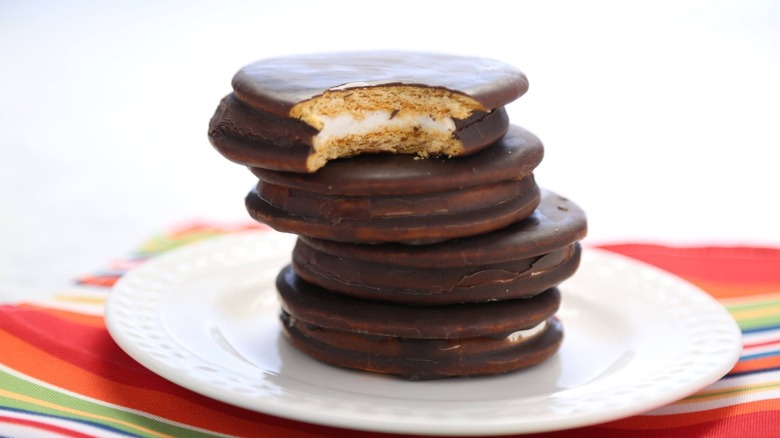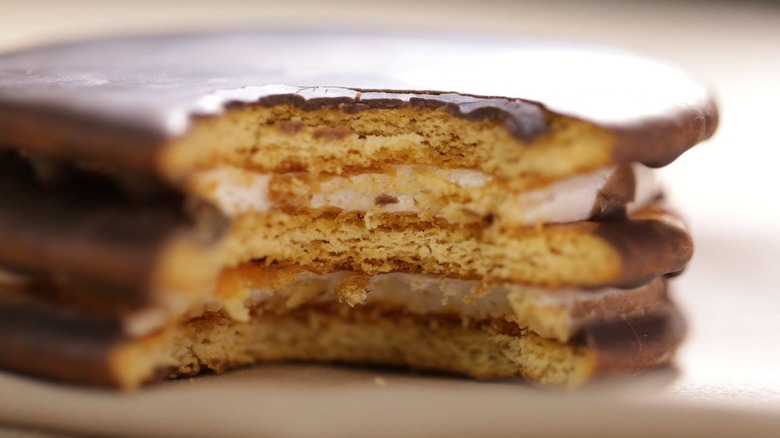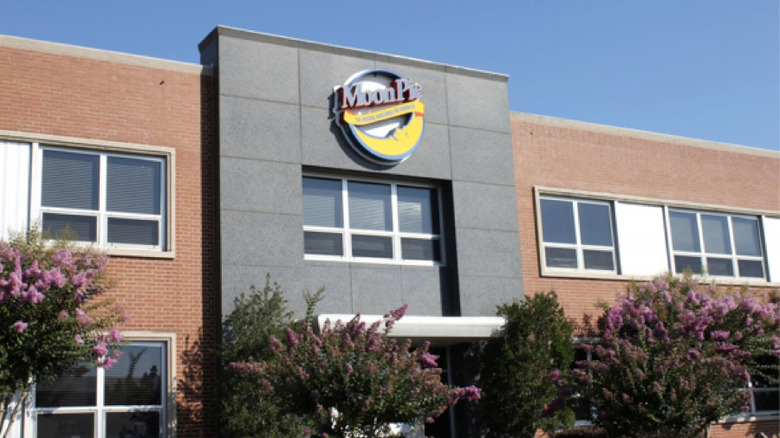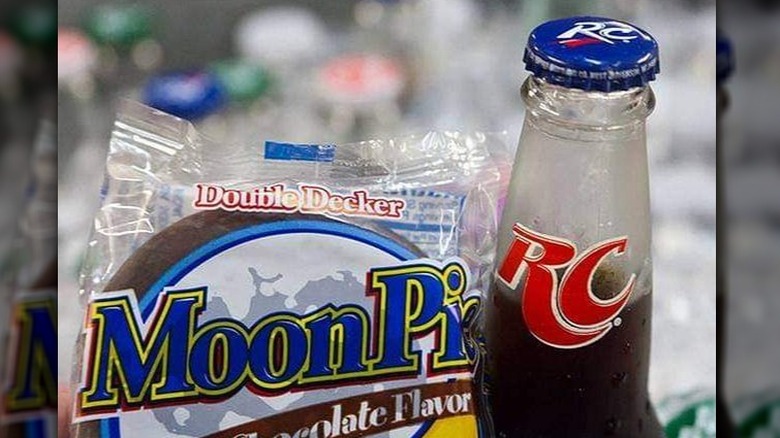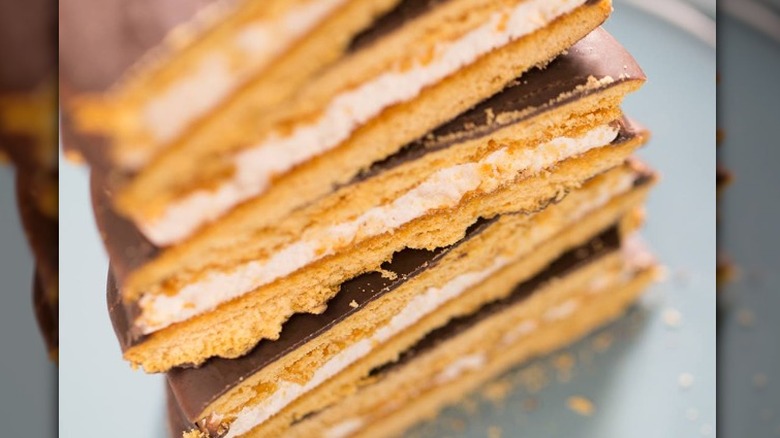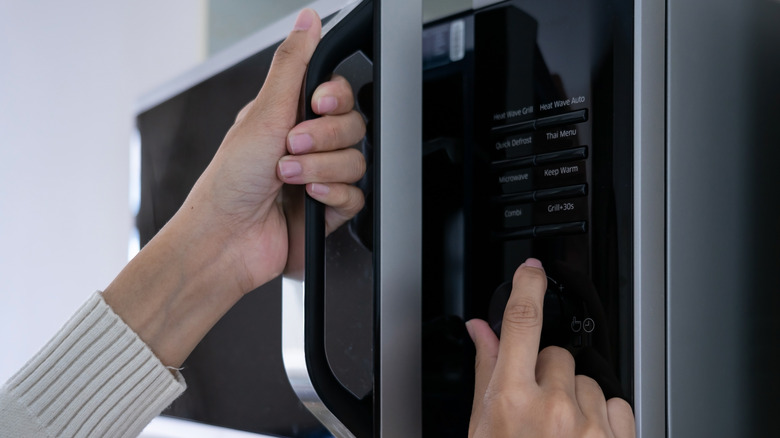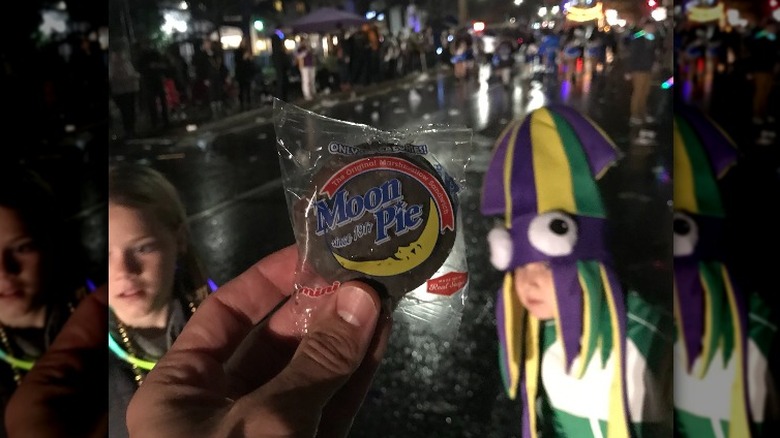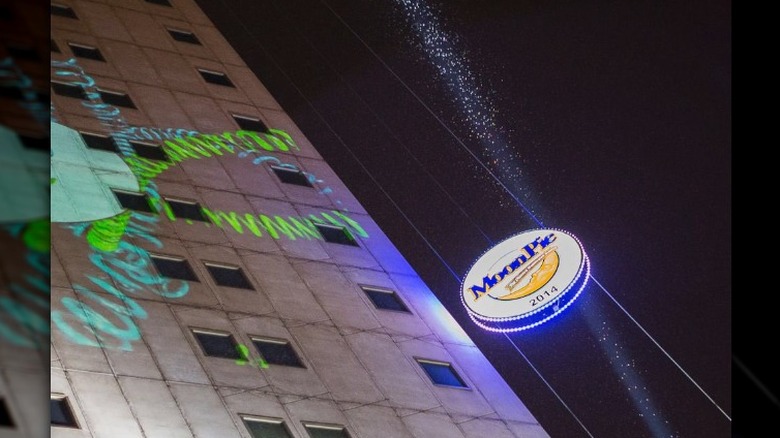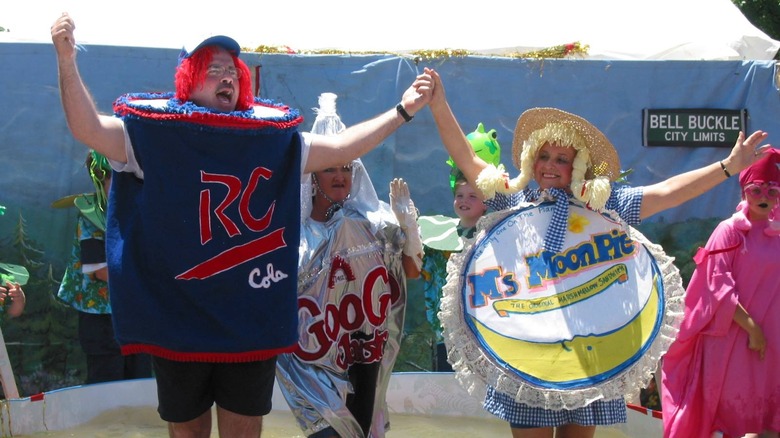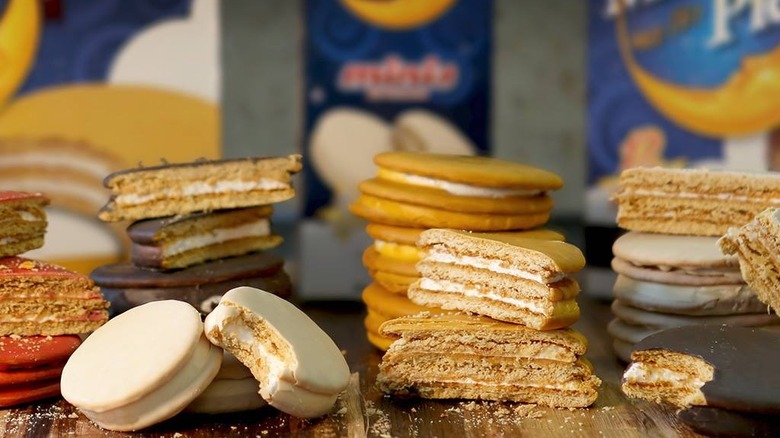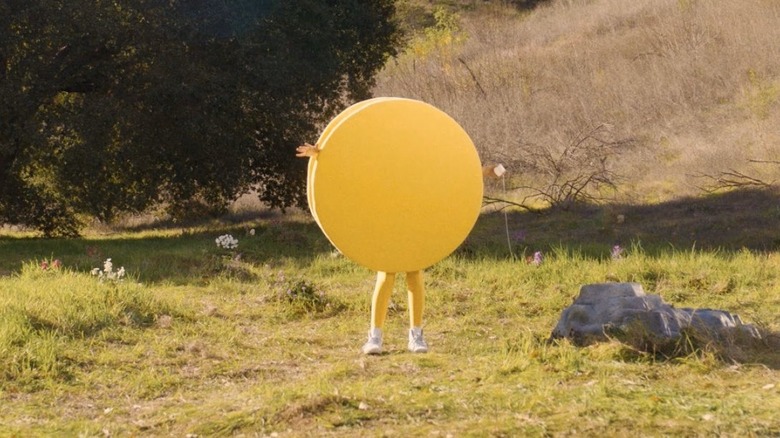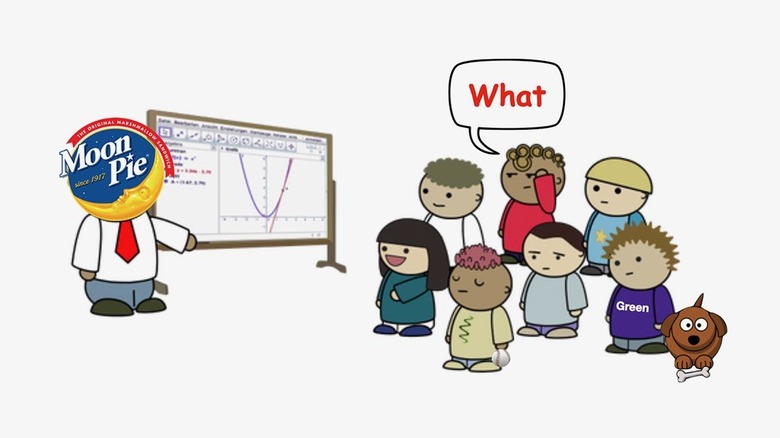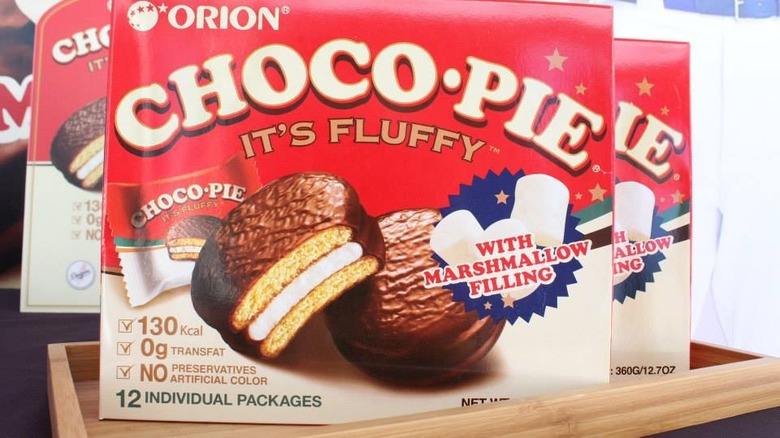The Untold Truth Of MoonPie
Created in 1917, MoonPies are more than a century old, and there's something certainly nostalgic about these circular, chocolate-covered treats, especially if you grew up in the South. For the uninitiated, a MoonPie consists of two graham cracker-esque cookies, filled with a fluffy marshmallow center, and then surrounded by a chocolate coating. Sometimes the coating is another flavor, like banana or salted caramel, but the OG MoonPie is chocolate all the way. Newer versions are also available with double-decker cookies, for more filling; on the flip side, you can also now buy miniature versions. With a simple flavor profile reminiscent of s'mores, there's a lot to love about this classic trear.
But where did the MoonPie come from? And why was it named after the moon? And how'd it manage to stick around for so long, in a landscape of ever-evolving snack foods? Here's everything you need to know about the history and culture of the MoonPie.
MoonPies were developed to feed coal miners
MoonPies are an invention of Chattanooga Bakery, Inc. Per NPR, in 1917, bakery employee and traveling salesman Earl Mitchell asked a Kentucky coal miner at a company town his opinion on snack foods. The miner said he craved a graham cracker and a marshmallow combined, dipped in chocolate ... and the rest is history.
Stories about the MoonPie's conception all refer back to this unnamed coal miner, but they differ as far as where the MoonPie got its name. One theory, as Food and Wine notes, is that the coal miner, when asked how large this snack cake should be, replied "as big as the moon." Another posits that the miner was a little more obtuse, simply holding his hands up to the moon in the night sky.
However the MoonPie got its name, though, Mitchell took the idea back to the Chattanooga Bakery and it wasn't long before the factory was turning out MoonPies aplenty.
Chattanooga Bakery wasn't just in the MoonPie business
Today, Chattanooga Bakery is still churning out MoonPies, as the operational name behind the brand, but this multi-million dollar company was focused on a lot more than just MoonPies when the now-famous snack got its start (via Encyclopedia.com). The bakery, established in 1902, started as a way for its parent company, Mountain City Flour Mill, to use up all its excess flour. Mountain City Flour would send over all its extra flour and then it was up to Chattanooga Bakery to find something profitable to do with it. In the early 1900s, the product line focused on baked goods such as sugar cookies, ginger snaps, and lemon cookies — and then, eventually, the MoonPie.
Before the MoonPie was on consumer shelves, the bakery would sell its existing cookies to miners in the Appalachian region to feed them on the job, but it was complaints that these cookies were just too insubstantial that supposedly prompted our unnamed miner hero to approach Earl Mitchell with his idea.
MoonPies became a popular Depression-era lunch
MoonPies were sold for just a nickel each when they first came out, and, as NPR reports, they were larger than competing snacks of the day, making them a popular choice for the working class individual picking up a quick lunch at the corner store. Eventually, MoonPies became known as a popular item to pair with an RC Cola, which was also sold at a nickel per bottle, creating a lunchtime pairing for just a dime.
The combination of a MoonPie and an RC Cola lasted much longer than the Great Depression, though, and gained widespread popularity beyond the working class. As one woman tells NPR, her uncle, a dentist, had a very peculiar ritual that combined the two items to help patients get in one last, quick sugary fix before their teeth cleaning: "He had a very interesting office, but every time you went, before you had your teeth cleaned, you had to drink an RC Cola and eat a MoonPie, then you got your teeth cleaned."
The MoonPie got a makeover in the 1960s
By the time the 1960s rolled around, there was a new spot to find your favorite snack cakes beyond the corner store: the nearest vending machine. But MoonPie ran into a problem. Its existing snack cake was too light to work in tandem with the vending machine's weight-based mechanisms (via Encyclopedia.com). So, the Chattanooga Bakery gave the MoonPie a makeover, creating the Double Decker MoonPie, which featured an additional layer of graham cracker cookie and marshmallow filling. This addition of the extra layers increased the MoonPie's weight by three ounces, allowing it to feasibly work in the new vending machines.
But, the change benefited Chattanooga Bakery in other ways as well. The increased size of the new product spurred the bakery to raise the price of a MoonPie from a nickel to a dime. Within just a few years of its introduction, the Double Decker MoonPie accounted for half of the bakery's sales.
Microwaves bring new magic to the MoonPie
The first home microwave was introduced in 1955, according to Live Science, but it wouldn't be until 20 years later that microwaves became truly popular. As Popular Mechanics reports, by 1975, sales of microwaves reached 1 million units. With this widespread popularization of the appliance, consumers discovered a new way to enjoy their MoonPies: microwaved. In fact, Eater claims that a zapped MoonPie is a superior MoonPie, and for good reason. The treat already contains all of the components of the beloved American s'more, so why not heat up those three ingredients — graham crackers, chocolate, and marshmallow — so that they more closely resemble the campfire favorite?
Alabama-based AL.com recommends microwaving the MoonPie on a plate for approximately 15 seconds and then taking things further with a scoop of vanilla ice cream and maybe even a bit of chocolate syrup, a concoction called the Hot Fudge Moon Pie which the publication credits to Chattanooga Bakery.
MoonPies and Mobile, Alabama are inseparable
It makes sense that AL.com would know all about the best way to level up your MoonPie, because the confection has strong ties to the Southern state, particularly to the city of Mobile. While the MoonPie may have gotten its start in Tennessee, it was Mobile that decided to adopt MoonPies for its long-standing Mardi Gras traditions.
Today, you can attend Mobile Mardi Gras celebrations and find participants throwing MoonPies in droves to the watching crowds. According to Southern Kitchen, the tradition began in the 1940s and 1950s, when parade organizers were looking for something soft to throw to the onlookers. After considering Cracker Jack, which were still too pointy and unwieldy in their boxes, they settled on MoonPies, noting that the treat had the perfect balance of softness and weight, so they'd fly easily into the crowds without wounding anyone. It also helped that MoonPies were cheap. It's now estimated that Mobile Mardi Gras revelers throw as many as 500,000 MoonPies each year.
Mobile even boasts one humongous MoonPie
Beyond the half-million MoonPies that are tossed during Mardi Gras, Mobile has found way to tie the city's love of the indulgence to New Year's Eve, with a midnight MoonPie drop. While, in years past, the city has had a smaller MoonPie replica to help ring in the new year, in 2019, city leaders constructed a particularly humongous, glowing MoonPie to lower at midnight (via AL.com). The Mobile city council spent $9,000 to create the 12-foot, 600-pound MoonPie which features more than a thousand lights. According to one council member, the MoonPie was chosen for the New Year's Eve celebration simply because it's basically the only thing that everyone in Mobile can agree on. "It cuts across economic status. It cuts across race. The MoonPie brings people together," he said. "If I had picked some other object, it could have divided the community, but the MoonPie — nobody has anything against the MoonPie."
Unfortunately for purists, the mega-sized MoonPie wasn't modeled after the original version of the treat, but instead the banana-flavored MoonPie, which is yellow.
Tennessee honors the MoonPie in its own way
But it's not just Mobile that loves all things MoonPie. The MoonPie's home state of Tennessee also shows the treat some love, with an annual MoonPie festival — but it's not just a MoonPie festival. Instead, Bell Buckle, Tennessee hearkens back to the classic combo of a MoonPie and RC Cola, with the RC Cola MoonPie Festival. According to Atlas Obscura, the festival — during which thousands of revelers descend upon this tiny town that's normally a population of just a few hundred — is held every third Saturday of June and has been an annual occasion since 1992. The festivities typically include live music, a parade, games, a marathon, and some really big MoonPies, plus free MoonPies and RC Cola.
For 2021, the festival theme was "Making Lemonade Out of Lemons," as a nod to the COVID-19 pandemic, and coincided with the re-release of the lemon-flavored MoonPie, the first time that Chattanooga Bakery had offered the flavor in more than a decade.
Chattanooga Bakery resisted advertising the MoonPie
Considering how popular MoonPies became, one might assume that Chattanooga Bakery spent a pretty penny on advertising and marketing ... right? But it turns out that for more than 50 years, Chattanooga Bakery never spent a dollar on formal advertising for the MoonPie, according to Sam Campbell IV, the third generation of Campbells to oversee Chattanooga Bakery (via a 1986 interview with The New York Times). Despite that fact, though, the MoonPie received tons of media attention over the decades, as well as loads of attention from stalwart fans from across the country. "The MoonPie is a bedrock of the country store and rural tradition," William Ferris, the director of the University of Mississippi's Center for the Study of Southern Culture, told The New York Times. "It is more than a snack. It is a cultural artifact."
The New York Times noted that The Campbell family would not disclose any figures regarding any aspect of their business and would not allow cameras inside the MoonPie plant. In fact, they wouldn't even allow visitors to get too close to the plant machinery.
MoonPie eventually decided to advertise in a weird way
The ban on advertising didn't ultimately last, and when MoonPie did decide to advertise, it decided to go hard or go home. MoonPie hired an ad agency, the Tennessee-based Tombras Group, to direct its efforts and the results, as Muse reports, were striking. For one campaign, MoonPie ran a series of Super Bowl ads ... just not on your home television. Instead, the commercials for the big game only ran on televisions in gas stations. For another campaign, MoonPie simply wrote some commercial scripts and published those, versus making the actual commercials. (The commercials were eventually made, partially because MoonPie's followers got a kick out of the scripts.)
Despite their overall weirdness, the ad agency's ideas worked, as Tombras' executive vice president reported that MoonPie's sales were on the rise despite no new products, no increased distribution, no discounts, and no TV ads (unless you count the gas station televisions). According to Fast Company, soon after Tombras joined the team, MoonPie sales were up 17%.
Tombras fine-tuned MoonPie's social media presence
Tombras Group didn't just help MoonPie out with its advertising, the firm also completely revamped the brand's social media presence. With a 26-year-old social media manager at the helm of MoonPie's Twitter account, BuzzFeed reports that the MoonPie Twitter brand became "hysterically weird," while Mashable describes the account as "strangely satisfying" and "occasionally bizarre." With an off-the-cuff, sassy style similar to what consumers have already watched work for brands like Wendy's, the MoonPie Twitter-verse became entrenched in clap backs of all types, taking on other brands, like Hostess, as well as politicians and just plain ol' commenters.
Today, MoonPie has more than 289,000 followers on its Twitter account and the bizarre branding has even gone so far as to carefully fine-tune MoonPie's "following" list to include a random mix of comedy accounts, brands like Pop-Tarts, as well as a few oddities, like Merriam-Webster and Jason Derulo. They also, of course, follow the official account for Earth's Moon.
A MoonPie copycat in South Korea?
MoonPies are a relatively simple concept, when you get right down to it. So, it should be no surprise that someone else in some other part of the world might come up with the idea to coat a marshmallow-filled cookie sandwich with chocolate. For fans, though, the closest thing to a real MoonPie is the South Korean Choco Pie, which boasts a pretty intense following of its own.
Choco Pies, as Business Insider reports, are so popular that they're sold on the black market in North Korea, at an estimated rate of nearly 2.5 million per month. Some North Korean employees are paid in Choco Pies. South Korea has airlifted Choco Pies to North Korea in the past. One North Korean soldier who defected to South Korea was even given a lifetime supply of Choco Pies as a reward.
But, how does the Choco Pie stand up to the MoonPie? According to Carving a Journey, the Choco Pie format is just about identical, with a marshmallow filling between two thin cakes covered in chocolate. The food blogger also notes that Choco Pies were directly inspired by MoonPies. A Korean businessman ate a MoonPie during a trip to Georgia and brought the concept back to South Korea, where he created the Choco Pie.
